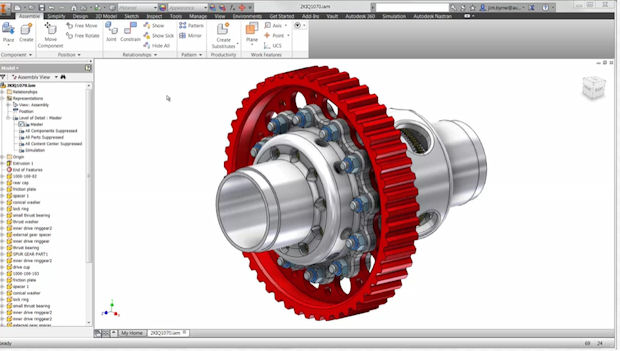Editor’s Pick: Nastran for Inventive Designers

This image taken from a video demonstration shows how from inside of Autodesk Inventor users can leverage Autodesk Nastran In-CAD to simulate the extreme conditions endured by a bolted connection within a differential. Image courtesy of Autodesk Inc.
Latest News
January 23, 2015
 Dear Desktop Engineering Reader:
Dear Desktop Engineering Reader:
 Back in the spring of 2014, Autodesk “acquired certain assets” of NEi Software and the NEi Nastran platform. They did not make a formal announcement of it. Why? Well, blogging about this event the shortly after, Autodesk’s Derrek Cooper described the acquisition as a “big move toward a broader strategy that will unfold in the coming months.”
Back in the spring of 2014, Autodesk “acquired certain assets” of NEi Software and the NEi Nastran platform. They did not make a formal announcement of it. Why? Well, blogging about this event the shortly after, Autodesk’s Derrek Cooper described the acquisition as a “big move toward a broader strategy that will unfold in the coming months.”
“Big move” seems to be an understatement. Over the years, CEO Dave Weinberg and his team at NEi Software did a great job building and nourishing NEi Nastran, now called Autodesk Nastran.
Simply put, Autodesk Nastran is a structural analysis workhorse. It’s a high-level, validated and time-tested solver for gnarly FEA (finite element analysis) jobs involving things like static stress with linear material models, modal analyses, linear buckling and steady-state heat transfers. It handles composites, structural harmonic response, interactions between parts, random loads and the like. And it provides you real-time results and solution changes.
Users of Autodesk Simulation Mechanical were the first to reap the benefits of Autodesk Nastran when it was released as an integration for Simulation Mechanical during a subscriber update. Recently, however, some more of that “broader strategy” has unfolded: Inventor users can now get in on Autodesk’s big move into structural and mechanical analyses in the form of Autodesk Nastran In-CAD 2015 for Inventor.
Autodesk Nastran In-CAD for Inventor is a fully embedded, general-purpose set of FEA tools that’s powered by the Autodesk Nastran solver. It provides you a palette of simulation tools for basic analyses such as exploring the viability of design alternatives and concept validation from inside of Inventor. Among its stress analysis functionalities are static fatigue, linear buckling, heat transfer and stress, strain and deformation.
Autodesk Nastran In-CAD for Inventor is not your granddaddy’s embedded analysis toolset. See, by leveraging the Autodesk Nastran platform, it also gives you highly-advanced analysis capabilities like impact, random vibration fatigue, nonlinear static and transient response. You can run simulations with composites, conduct virtual drop tests, study nonlinear materials and even simplify working with a huge number of solid elements by making them 1D line elements.
Additionally, Autodesk Nastran In-CAD 2015 for Inventor deploys with capabilities like intelligent, associative meshing so that your meshes update as your model changes. It has a materials library, automatic surface meshing and automatic tetrahedral meshing. You can create animations as well as customize result types and presentations.
Two side notes: First, Autodesk Nastran In-CAD 2015 has a flexible licensing policy that allows you to share one license of the software across multiple CAD platforms. Second, there’s a version of Autodesk Nastran In-CAD 2015 for SolidWorks as well. That product and its user base came as part of the acquisition. Keeping the faith with those users is a class move on Autodesk’s part.
Frankly, there’s way too much to say about Autodesk Nastran In-CAD 2015 for Inventor in such little space. So, here’s what you can do. First, hit today’s Pick of the Week link and go to the end of the write-up.
Once there, hit the first link. It’ll take you to a dedicated information page on Autodesk Nastran In-CAD 2015 for Inventor. That page has five, registration-free videos that’ll show you what Autodesk Nastran In-CAD 2015 could mean to you when it comes to analyzing for failure, buckling, nonlinear, thermal and fatigue directly in Inventor. Make sure to hit the “learn more” link just below the video player. It’ll take you to even more videos on more analysis types. This is really good stuff.
Thanks, Pal. — Lockwood
Anthony J. Lockwood
Editor at Large, Desktop Engineering
Read today’s pick of the week write-up.
This is sponsored content. Click here to see how it works.
Subscribe to our FREE magazine, FREE email newsletters or both!
Latest News
About the Author
Anthony J. Lockwood is Digital Engineering’s founding editor. He is now retired. Contact him via [email protected].
Follow DE





